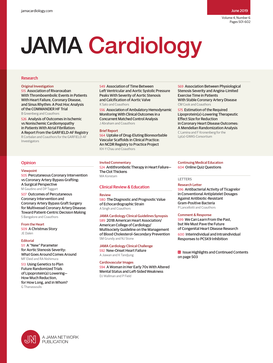Electrocardiogram vs Electrophysiological Study and Major Conduction Delays in Myotonic Dystrophy Type 1.
IF 14.1
1区 医学
Q1 CARDIAC & CARDIOVASCULAR SYSTEMS
引用次数: 0
Abstract
Importance For the prevention of sudden cardiac death in myotonic dystrophy type 1 (dystrophia myotonica; DM1), professional practice guidelines recommend pacemaker implantation in asymptomatic patients with a PR interval greater than or equal to 240 milliseconds and/or QRS duration greater than or equal to 120 milliseconds on electrocardiogram (ECG), or a His-ventricular (HV) interval greater than or equal to 70 milliseconds during electrophysiological study (EPS), as class IIa indications. Objective To determine which of these strategies-ECG or EPS based-is more effective in predicting major bradyarrhythmic events (MBAEs). Design, Setting, and Participants This was a cohort analysis of retrospectively collected longitudinal data from the DM1 Heart Registry. The setting included cardiology and neurology departments of 6 French university hospitals. Study participants were selected from individuals enrolled in the DM1 Heart Registry between 2000 and 2020. The DM1 Heart Registry includes adults with genetically confirmed DM1. Included patients had a history of first EPS after 1999 and no personal history of advanced atrioventricular block or sustained ventricular tachycardia. Study data were analyzed from January to July 2025. Exposures ECG- and EPS-based strategies. Main Outcomes and Measures The primary outcome was MBAEs, defined as sudden cardiac death, resuscitated cardiac arrest, or second-degree type II or complete atrioventricular block. Results Of 1778 adults with genetically confirmed DM1 enrolled in the DM1 Heart Registry, a total of 706 patients (mean [SD] age, 42 [13] years; 359 male [51%]) were included in this study. At baseline, 273 patients (38%) had an HV interval greater than or equal to 70 milliseconds, and 232 (32%) met ECG criteria. Over a median (IQR) follow-up of 5.9 (2.3-9.7) years, 99 patients (14%) experienced an MBAE. In multivariable Cox and joint models incorporating baseline and time-varying values of PR and QRS durations, the HV interval was the only variable significantly associated with the incidence of MBAEs (hazard ratio [HR], 1.77; 95% CI, 1.46-2.16; P < .001 and HR, 1.78; 95% CI, 1.40-2.22; P = .001, respectively). Compared with ECG-based criteria, the EPS criterion proved to be a more reliable (HR, 2.89; 95% CI, 1.92-4.34 vs HR, 1.95; 95% CI, 1.31-2.89) and more sensitive (performance index [SE], 68.35% [6.24%] vs 34.76% [6.47%]) predictor of MBAE and accurately reclassified 28.8% of patients with an MBAE. Lowering the threshold to HV greater than or equal to 65 milliseconds further improved sensitivity (performance index [SE], 90.18% [3.85%]) and net reclassification improvement (33.7%; 95% CI, 19.6%-48.2%) for MBAE prediction. Conclusions and Relevance In this cohort of patients with DM1, the HV interval outperformed ECG criteria in predicting MBAEs. An HV threshold greater than or equal to 65 milliseconds may enhance risk stratification for prophylactic pacing.1型强直性肌营养不良患者的心电图与电生理研究及主要传导延迟。
重要性为预防1型肌强直性营养不良(肌强直性营养不良;DM1)的心源性猝死,专业实践指南建议对无症状的PR间期大于或等于240毫秒和/或心电图QRS持续时间大于或等于120毫秒,或电生理研究(EPS)时HV间期大于或等于70毫秒的患者植入起搏器,作为IIa类适应症。目的确定哪一种策略(ecg或EPS)更有效地预测主要心律失常事件(MBAEs)。设计、环境和参与者:这是一项对DM1心脏登记处回顾性收集的纵向数据的队列分析。设置包括6所法国大学医院的心内科和神经内科。研究参与者是从2000年至2020年间登记在DM1心脏登记处的个人中挑选出来的。DM1心脏登记包括基因证实患有DM1的成年人。纳入的患者1999年后有首次EPS病史,无晚期房室传导阻滞或持续性室性心动过速个人病史。研究数据分析时间为2025年1月至7月。暴露心电图和eps为基础的策略。主要结局和测量主要结局为MBAEs,定义为心源性猝死、复苏性心脏骤停、二级II型或完全房室传导阻滞。结果在DM1心脏登记处登记的1778名遗传确诊DM1的成年人中,共有706名患者(平均[SD]年龄42岁,其中359名男性[51%])被纳入本研究。在基线时,273例患者(38%)的HV间期大于或等于70毫秒,232例患者(32%)符合ECG标准。在中位(IQR)随访5.9(2.3-9.7)年期间,99名患者(14%)经历了MBAE。在包含基线值和时变PR和QRS持续时间值的多变量Cox和联合模型中,HV间隔是唯一与MBAEs发生率显著相关的变量(风险比[HR], 1.77; 95% CI, 1.46-2.16; P <。001, HR为1.78;95% ci, 1.40-2.22;p =。001年,分别)。与基于心电图的标准相比,EPS标准被证明是一个更可靠的MBAE预测指标(HR, 2.89; 95% CI, 1.92-4.34 vs HR, 1.95; 95% CI, 1.31-2.89)和更敏感(表现指数[SE], 68.35% [6.24%] vs 34.76%[6.47%]),并准确地重新分类了28.8%的MBAE患者。将阈值降低到HV大于或等于65毫秒进一步提高了MBAE预测的灵敏度(性能指数[SE], 90.18%[3.85%])和净重分类改善(33.7%;95% CI, 19.6%-48.2%)。结论和相关性在这组DM1患者中,HV间期在预测MBAEs方面优于ECG标准。大于或等于65毫秒的HV阈值可能会增加预防性起搏的风险分层。
本文章由计算机程序翻译,如有差异,请以英文原文为准。
求助全文
约1分钟内获得全文
求助全文
来源期刊

JAMA cardiology
Medicine-Cardiology and Cardiovascular Medicine
CiteScore
45.80
自引率
1.70%
发文量
264
期刊介绍:
JAMA Cardiology, an international peer-reviewed journal, serves as the premier publication for clinical investigators, clinicians, and trainees in cardiovascular medicine worldwide. As a member of the JAMA Network, it aligns with a consortium of peer-reviewed general medical and specialty publications.
Published online weekly, every Wednesday, and in 12 print/online issues annually, JAMA Cardiology attracts over 4.3 million annual article views and downloads. Research articles become freely accessible online 12 months post-publication without any author fees. Moreover, the online version is readily accessible to institutions in developing countries through the World Health Organization's HINARI program.
Positioned at the intersection of clinical investigation, actionable clinical science, and clinical practice, JAMA Cardiology prioritizes traditional and evolving cardiovascular medicine, alongside evidence-based health policy. It places particular emphasis on health equity, especially when grounded in original science, as a top editorial priority.
 求助内容:
求助内容: 应助结果提醒方式:
应助结果提醒方式:


